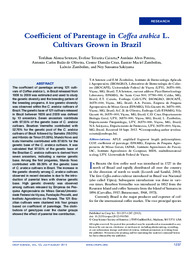Coefficient of parentage in Coffea arabica L. cultivars grown in Brazil.
Coefficient of parentage in Coffea arabica L. cultivars grown in Brazil.
Autoria: SETOTAW, T. A.; CAIXETA, E. T.; PEREIRA, A. A.; OLIVEIRA, A. C. B. de; CRUZ, C. D.; ZAMBOLIM, E. M.; ZAMBOLIM, L.; SAKIYAMA, N. S.
Resumo: The coefficient of parentage among 121 cultivars of Coffea arabica L. in Brazil released from 1939 to 2009 was estimated and used to study the genetic diversity and the breeding pattern of the breeding programs. A low genetic diversity was observed within the C. arabica cultivars of Brazil. The genetic base of 121 cultivars released in Brazil between 1939 and 2009 was defined by 13 ancestors. Seven ancestors contribute with 97.55% of the genetic base of C. arabica cultivars. Bourbon Vermelho contributed with 52.76% for the genetic pool of the C. arabica cultivars of Brazil followed by Sumatra (19.05%) and Híbrido de Timor (11.59%). Mundo Novo and Icatu Vermelho contributed with 87.65% for the genetic base of the C. arabica cultivars. It was calculated that 97.55% of the genetic base of the Brazilian C. arabica cultivars is derived from seven ancestors, indicating a narrow genetic base. Among the first progenies, Mundo Novo contributed with 69.39% of the genetic base of C. arabica cultivars in Brazil. The increase in the genetic diversity among C. arabica cultivars observed in recent decades is due to the introduction of parental lines with diverse genetic base. High genetic diversity was observed among cultivars released by Empresa de Pesquisa Agropecuária de Minas Gerais/Universidade Federal de Viçosa, Fundação Procafé, and Instituto Agronômico do Paraná. The 121 Brazilian cultivars were clustered into four groups based on coefficient of parentage. The distributions of genotypes over the cluster groups showed the effect of parental line contribution.
Ano de publicação: 2013
Tipo de publicação: Artigo de periódico
Unidade: Embrapa Café
Palavras-chave: Coffea Arábica
Observações
1 - Por padrão são exibidas publicações dos últimos 20 anos. Para encontrar publicações mais antigas, configure o filtro ano de publicação, colocando o ano a partir do qual você deseja encontrar publicações. O filtro está na coluna da esquerda na busca acima.
2 - Para ler algumas publicações da Embrapa (apenas as que estão em formato ePub), é necessário ter, no celular ou computador, um desses softwares gratuitos. Sistemas Android: Google Play Livros; IOS: iBooks; Windows e Linux: software Calibre.
Acesse outras publicações
Acesse a Base de Dados da Pesquisa Agropecuária (BDPA) para consultar o acervo completo das bibliotecas da Embrapa.

